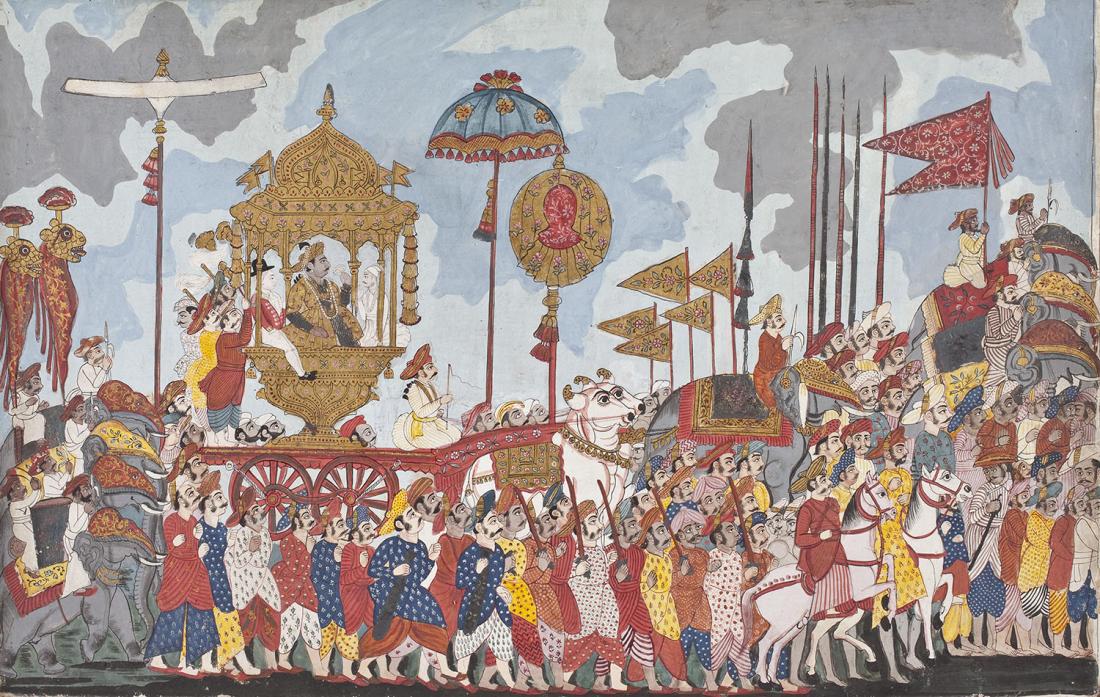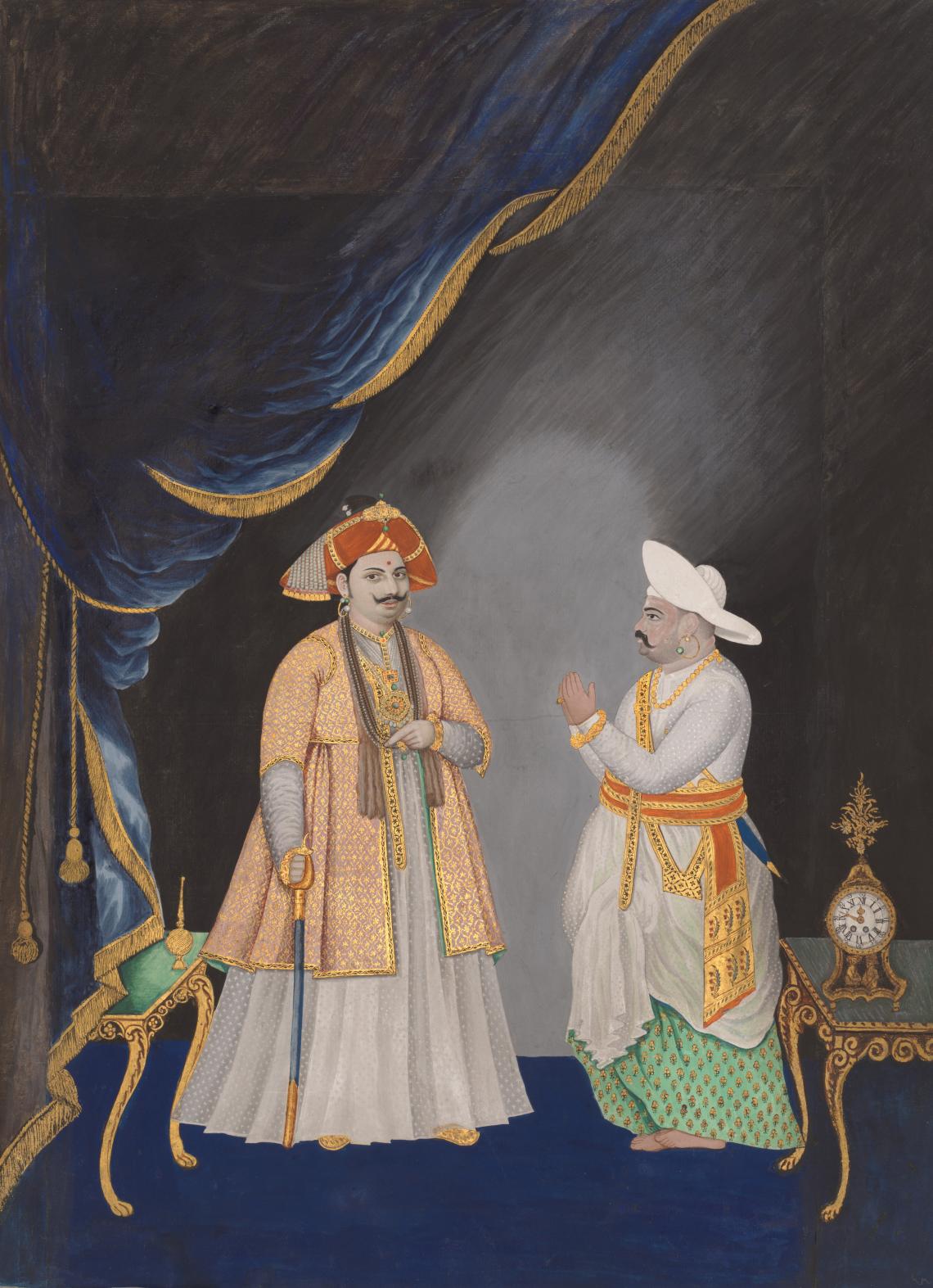Royal Procession with Raja Amar Singh of Thanjavur, Thanjavur (Tanjore), Tamil Nadu, India, c. 1790, Opaque watercolour and gold on paper, 40.64 x 65.41 cm.
A style of painting developed in and around the area of Thanjavur in present-day Tamil Nadu, Thanjavur painting emerged in the early seventeenth century under the patronage of the Nayaka rulers of the region. Traditionally intended as objects of worship, the paintings are generally made on cloth and often represent a deity at the centre, shown in a tranquil pose and surrounded by its avatars, vahanas, consorts, attendants or devotees composed in a single plane. The style is characterised by tonally flat but boldly coloured backgrounds, and the gilding techniques and gem-setting used to depict the elaborate jewellery worn by the subjects of the works. While Thanjavur paintings originally featured gods and saints, usually derived from Vaishnava myths and epics such as the Ramayana, they were later also used for secular and courtly portraiture, especially of Maratha rulers.
After the dissolution of the Vijayanagara Empire in the late-sixteenth century, Thanjavur emerged as a major cultural, religious and economic centre. Painters of the Kshatriya caste from the Telugu-speaking regions of present-day Andhra Pradesh migrated there in search of patronage. These early painters of Thanjavur were influenced by surviving examples of Chola murals from the region, as well as techniques of sculpture and Kalamkari textile production of the time. According to scholars, other influences include the Vijayanagara painting tradition from the regions corresponding to present-day Karnataka, Andhra Pradesh and Telangana; and the paintings of Masulipatnam (now Machilipatnam) in the Golconda Sultanate, and Tirupati, then a major centre of South Indian pilgrimage, commerce and art, in present-day Andhra Pradesh. These imparted a mix of Deccani, Persianate and southern Indian elements to the emerging Thanjavur style.
Early Thanjavur painting primarily depicted Hindu divinities in stiff poses and static compositions, gilded with gold leaf. However, after the Maratha conquest of Thanjavur in the late seventeenth century, the style began to be used in secular portraiture as well. The popularity of Thanjavur paintings grew rapidly under the patronage of these rulers. Several Maratha kings, especially Venkoji and Pratap Singh, commissioned paintings depicting themselves in various courtly contexts. Thanjavur-style portraits of this period incorporate both Mughal and Maratha elements, but their compositions tend to centre the monarch and use brighter colours and more dynamic poses. Later portraits incorporate techniques of shading and three-dimensional perspective, and include elements like curtains or pillars and views of architectural spaces, possibly due to interactions with European art. By the end of the eighteenth century, the Maratha court at Thanjavur had become a centre for the diffusion of styles and artists to other South Indian centres of painting such as Pudukottai, Trichinopoly (now Tiruchirappalli), Madurai and Srirangam, in present-day Tamil Nadu.
Maharaja Serfoji II Accompanied By His Minister, Thanjavur School, Tamil Nadu, India, c. 1800, Opaque watercolour with raised gold on paper, 59.7 × 43.8 cm.
Over the next century, the Thanjavur region increasingly came under British control, leading painters to incorporate techniques from the Company School of painting. The media used changed from ground colours on cloth and wood to gouache and watercolour on paper. The style also began to move beyond the court and reached new markets and classes of patrons. The British commissioned Thanjavur artists for ethnographic illustrations, while some Indian patrons employed them to make drawings of insects, birds and animals.
Simultaneously, Thanjavur-style religious paintings also underwent considerable change. Glossy paintings of deities such as Krishna, with cherubic forms and gilded decoration, were produced for a popular market. Owing partly to the influence of Academic Realism from the West, stiff poses gave way to more naturalistic depictions. Expensive gold leaf was still applied to some of these works, while others began to use cheaper gold paper for embossing. Many of these innovations are still used in Thanjavur paintings today.
Contemporary Thanjavur paintings are large, framed objects meant to be hung on walls and seen from a distance. They are generally executed on wooden panels wrapped in cloth, leading them to be called palagai padam (Tamil for ‘pictures on wood’). The wood of the jackfruit tree is usually preferred for this purpose. A sheet of cardboard is pasted onto the panel using gum sometimes made from tamarind seeds. This is covered with one or two layers of cloth, which is coated with lime and smoothed down using a stone or shell. The painting is done using a brush on this prepared surface, leaving out the places where gems are to be set. These spots are marked with unboiled limestone that is ground and mixed with glue, and gems or stones are directly embedded here, followed by the application of gold leaf or paper. Embossing is achieved by pressing the foil down with the pointed end of a paintbrush. More recent Thanjavur paintings bear heavier applications of gold work and a few dark, rich shades of colour. The background colours used include deep greens, blues or reds; the main figures are usually executed in white, yellow, green or blue.
The influence of the Thanjavur painting style has had considerable geographic and temporal range. According to some scholars, elements of the style influenced paintings produced as far away as Solapur in Maharashtra as well as various parts of Karnataka in the eighteenth century. Its depiction of deities with a hybrid of South Indian and European styles influenced Realist painters like Raja Ravi Varma, and inspired popular art in the form of prints and calendar paintings through the twentieth century and up to the present day.
Although the tradition of Thanjavur painting was historically limited to men of the Kshatriya caste, efforts have been made to open it up to others in recent years. The Tamil Nadu Handicrafts Development Corporation has conducted training courses in Thanjavur painting exclusively for women. Thanjavur paintings continue to be extremely popular as tourist memorabilia and objects of worship, and are among the most recognisable South Indian paintings today.
This article first appeared in the MAP Academy Encyclopedia of Art.
The MAP Academy is a non-profit online platform consisting of an Encyclopedia of Art, Courses and a Blog, that encourages knowledge building and engagement with the visual arts and histories of South Asia. Our team of researchers, editors, writers and creatives are united by a shared goal of creating more equitable resources for the study of art histories from the region.




